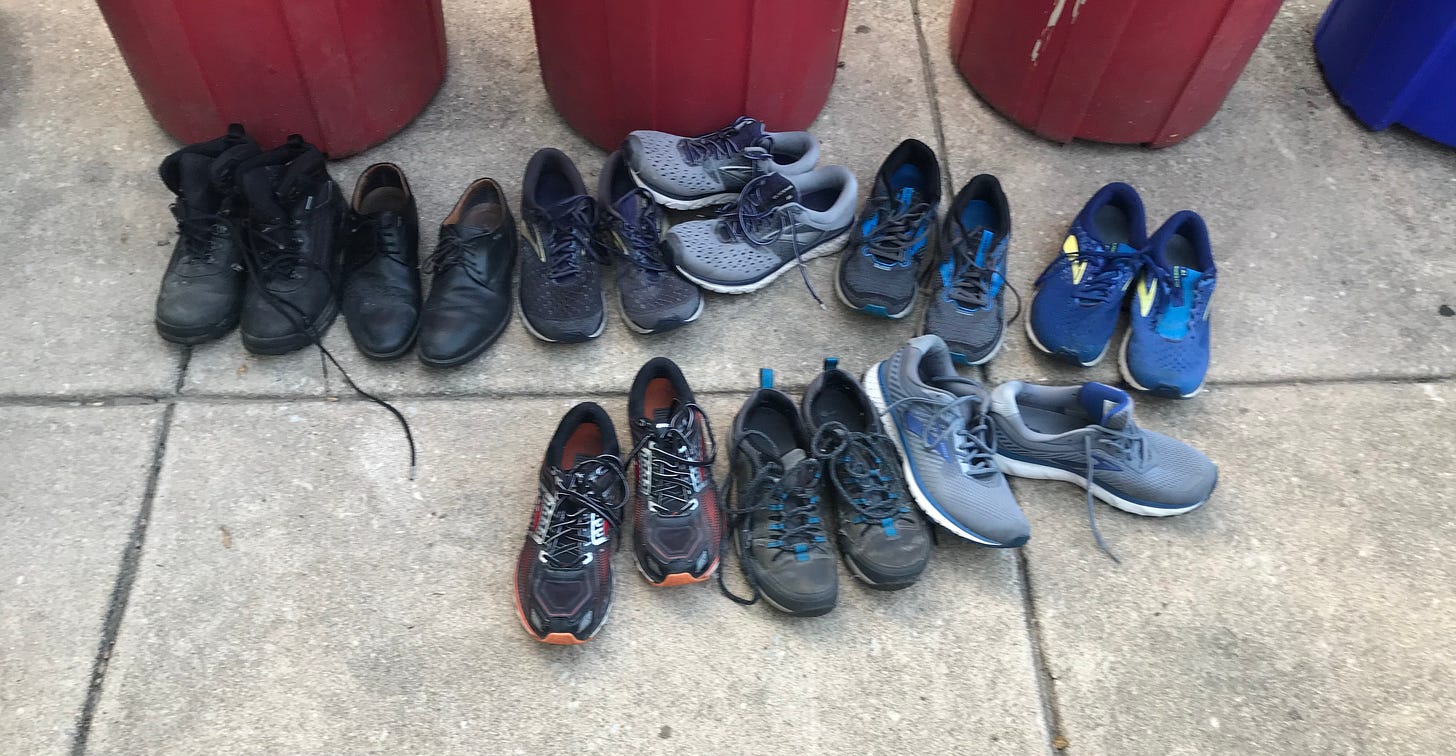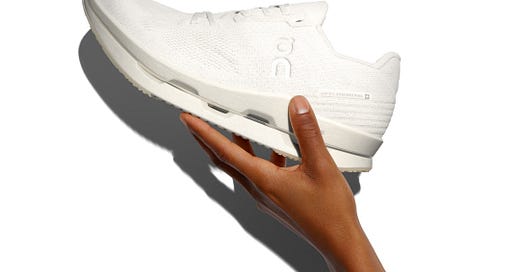The Subscription Economy Comes For Your Shoes
The Cloudneo sneakers made by running company "On" are branded as the shoes you never own – which raises questions about the limits of the circular economy
Something else we like besides right to repair here at Fight to Repair is running. Paul is a seasoned marathon runner. I'm a bit greener, since running was a habit I picked up at the start of the pandemic.
One thing that baffled me when I started running regularly was that long-distance runners are typically buying three new pairs of running shoes a year. Run for ten years, that's thirty pairs (sixty shoes!!) that end up in a landfill somewhere. Being someone that spends time thinking about our relationship with repair and the things we own, something doesn't sit right with me about this.

There's a sneaker made from beans – and you're not allowed to own it
Recently, I stumbled on a subscription running shoe service called "Cyclon" run through the Swiss shoe Company On – which brands itself as the shoe you will never own. Instead of trashing your old shoes, you send back the first pair you get to receive a new one. Through the wonders of modern science, your old stinky pair will be crunched up and used to make a brand new shoe.
The Cyclon program work like this: You sign up for the Cyclon subscription service and get a pair of shoes in the mail. You then send them back when you've run them into the ground and get a new pair in the mail. (Repeat ad infinitum.)
On's model for minimizing waste and energy while manufacturing their shoes is simple:
Use as little energy and as few raw materials as possible when making and shipping the shoes.
Rent the shoes out to customers.
Have customers send back their old shoes.
Recycle/Upcycle the old shoes to make new shoes.
What’s interesting (to me) is that On seems to have accepted that they are not going to fix our disposable culture (at least right now). Hence: the subscription service. In a clever way, they are actually using obsolescence to fuel their model of circularity. Without old shoes to be recycled into new shoes, the system wouldn't work.
It makes sense, especially given that members of my generation have never known a world without “fast fashion” predicated on disposability rather than durability, while older generations who grew up expecting clothes to last for years have heaved a collective shrug.
Emily Stochl, Director of Education & Community Engagement at Remake, a nonprofit fighting for fair pay and climate justice in the clothing industry says that generally, "brands have been very effective at manufacturing psychological obsolescence, in addition to actual physical breakdown of their products." Just like everything else be it technology or clothes, we are fed a narrative that new is always better.
This is why subscription services like Stitchfix, Amazon's personal shopper, and now On’s Cyclon exist; consumption and disposal of mass-manufactured goods that are only used for a short time is now a multi-billion dollar business in itself.
However, the difference between a Stitchfix and the Cyclon program is that Cyclon's motivation is to be environmentally friendly. What does this actually look like? On stipulates that compared to its regular running shoes, the Cyclon sneakers:
Produce 50% less CO2
Reduce energy consumption during manufacturing by 70%
Produce 90% less waste
More Beans, Less Waste
The shoe itself, dubbed the "Cloudneo,” is made from a bioplastic derived from castor beans. The material is both recyclable and less energy/emission intensive. And, by using this material, On is able to recycle the entire shoe rather than just discrete components.
In my mind, this is smart marketing which presents the shoe as environmentally friendly. However, bioplastics are not (as I initially thought) necessarily biodegradable. The shoe is roughly 50% bean but still contains a significant portion of plastic.
To participate in the program, customers pay $30 a month for shoes with the ability to send back a pair every six months – making each pair cost about $180 (which is a highly unrealistic price for your average person to spend on shoes). There is also currently a wait-list to even join the subscription program.
Breakthrough idea: make recycling compulsory
This model achieves reductions in waste, energy, and emissions in two ways:
Their subscription model forces rather than encourages shoes to be recycled, which cuts down waste in the shoes' lifecycle
By using old shoes as a raw material instead of entirely new materials, they reduce the amount of water, electricity, and plastic needed to produce a new shoe.
Supply chain efficiency is key
That said, On is strategic about their supply chain and how to best reduce emissions and materials both in the production of the shoe and the execution of the subscription service. For example, the upper part of the shoe is also made of one single material whereas other shoes might have many different types of materials. Through this, they don't need to ship a lot of different materials, and can simplify their supply chain. They also design the shoe to reduce cutting room scraps.
Supply chain efficiency also extends to fulfillment. You won't actually get your replacement shoes until enough people send theirs back in your area. That ensures that the company is shipping the shoes in bulk rather than single pairs.
The limits of technocratic solutions
A big reason I like repair is because I trust myself more than I trust corporations. (Though maybe Cyclon is an exception to that rule). I lean to repair and maintenance over offloading that responsibility to a company because corporations can, and do, lie to us. We can be fooled into thinking we are returning something to be refurbished or recycled while oftentimes it ends up in a landfill, leaving us none the wiser.
On's goal of reducing waste and emissions is admirable for any company. Even though they have taken an innovative approach to the problem of reducing waste while maintaining consumption levels (and hence profitability), there's no doubt in my mind the rest of the fashion industry will be dragged kicking and screaming before adopting such a model. In fact, there is evidence that bigger players are taking notice of this shift in consumer preferences. eBay recently announced a deal with Reskinned, a “pre-loved fashion” company that specializes in repairing and reselling used branded clothing.
In the meantime, I could be convinced to sign up for On’s Cyclon program. More broadly, however, I don't expect circular subscription models to swoop in to upend our society's habit of unfettered consumption.1 Repair and reuse are equally as important in the fight for climate justice as supporting a program like Cyclon. Both slow consumption and push back against the trend of low-quality, high-volume, and unethical manufacturing is needed to disrupt norms of the fast fashion industry.
Remake is subverting this idea with its #NoNewClothes pledge. It's a simple pledge – don't buy any new clothes for 90 days, instead stick to reusing, uplcycling, and thrifting new additions to your wardrobe. Stochl believes shifting our collective mindset is crucial to stem the tide of this obsolescence:
"The goal behind the #NoNewClothes pledge is to encourage consumers to reset their mindset around clothing consumption. We encourage people to build positive habits like mending, repairing, and rewearing their clothes first and foremost! We’ve all heard the adage – “the most sustainable item of clothing is the one already in your closet” – and we believe that!"
No Perfect Options
The sheer amount of waste that humans create is contributing to countless environmental crises. Textiles are just a single piece of the equation. Problems like biodiversity collapse, bioplastics, pollution, e-waste, and environmental toxicity are all made worse by the amount of items that we consume and trash. And while the reductions in carbon emissions and waste in producing the Cloudneo shoe are heartening, On remains a tiny player in a massive, global sneaker and clothing manufacturing marketplace.
I don't think we have the luxury of sitting around waiting for the perfect option to solve these problems. However, I strongly believe when it comes to our habits of consumption, a massive piece of solving our problems begins at the level cultural and societal understanding. Said another way: to reel in consumer culture, we need to demand a change in our relationship with our things. This is where repair comes in.
Practices like clothing repair (or abstention from buying new clothes) rarely receive the same attention as companies engineering some new product. One is clearly flashier than the other.
But consumption-driven economies are what got us into the situation we stand in today. It's unlikely they will get us out. This means culture-shifting habits that make us slow down and disrupt consumption, like up-cycling and repair, are more important than we are led to think.
I'm not covering On's labor practices in this piece, this would be another important facet to understand when thinking about their manufacturing with climate justice in mind.




